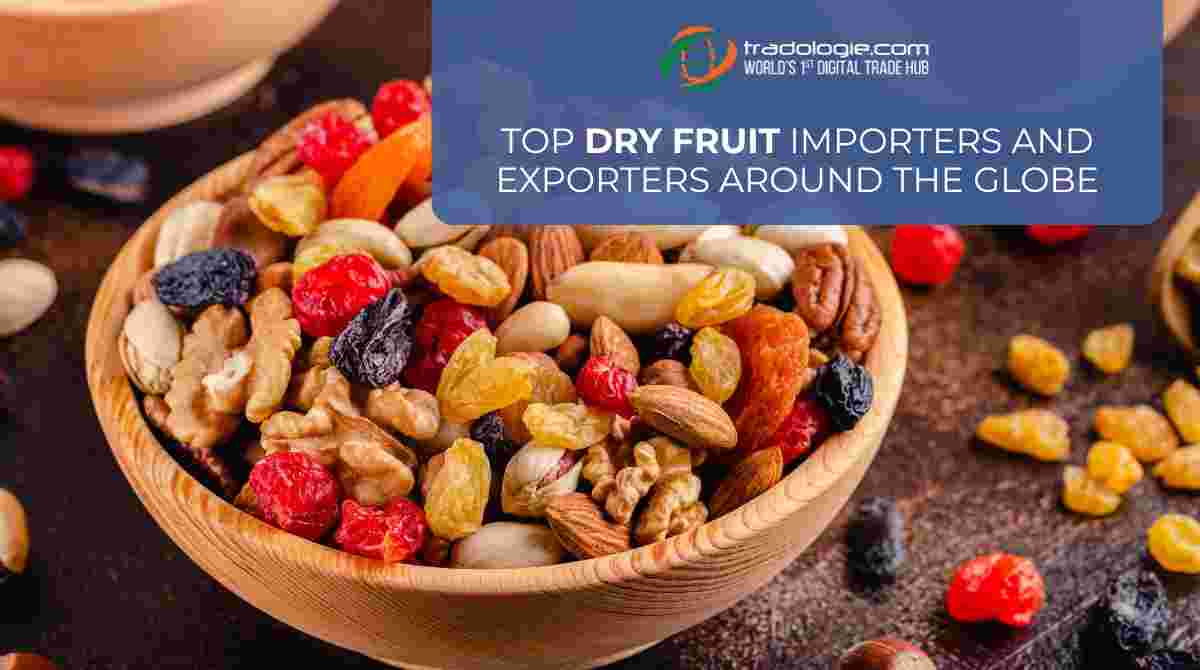Top Dry Fruit Importers and Exporters Around the Globe

Today we are going to discuss the demand & supply dynamics, market size, and how Tradologie is unlocking new potential for dry-fruit traders.
Dry fruits such as almonds, cashews, pistachios, walnuts, raisins, apricots, and more drive healthy snacking, demand from food manufacturers, and seasonal gifting cycles.
The following is a concise, data-driven look at the global dry-fruit market, including who is buying and selling, the structural drivers influencing flows and prices, and how modern B2B platforms like Tradologie are unlocking untapped potential for exporters and importers.
Market Size & Growth
As per recent market reports, the global dry-fruit market was valued at around USD 7.0–7.5 billion in 2024–25 and has a projected growth of around USD 10–11.8 billion by the early 2030s, reflecting a CAGR of 5% over the next decade. This shows a steady growth driven by health and natural ingredient industries.
Bulk Dry-Fruit Supplying Nations
A few countries dominate specific dry-fruit categories, accounting for the majority of global production.
Turkey, China, Iran, the United States, and India are among the world's largest producers of dried raisins and various tree nuts. Turkey, for example, accounts for a sizable portion of certain raisins and other categories.
Particularly when it comes to tree nuts, the US (California) is the top exporter of pistachios and almonds. For cashews, India and a number of West African countries are crucial; for walnuts and dried grapes/raisins, Turkey, Iran, and the US hold significant market shares.
Supply changes are frequently structural and difficult to reverse because production can be extremely weather-sensitive (heat waves, droughts) and capital-intensive.
Major Import Markets
The EU and the US are major consumers of almonds, walnuts, and mixed nuts, and they are consistently among the top dry-fruit importers by value, along with China and the Middle East.
The Middle East is a major importer of almonds, cashews, dates, and mixed dry-fruit gift assortments, while China consumes significant amounts of pistachios and other tree nuts. Different country-level import patterns for nuts and dried fruits across HS codes are reflected in trade databases.
Demand patterns
While some emerging markets show rapid growth (higher disposable incomes, gifting, and festive demand), developed markets show consistent year-round demand (snacking and ingredient use). Demand windows that are predictable but have a significant impact are created by seasonal spikes (holiday gifts, festivals).
Key demand drivers:
-
Healthy alternatives: consumer preference for nutrient-dense, plant-based snacks and protein-rich small meals.
-
Food industry demand: use of nuts and dried fruits in bakery, cereals, confectionery, and dairy products.
-
Gifting & seasonal demand: cultural/holiday spikes.
-
Retail channels: growth in private-label premium packaging and ready-to-eat mixes.
Volatility factors: Weather events and poor harvests (heatwaves, droughts) and reduced yields can rapidly push prices up.
Supply & Demand Creating Commercial Opportunity
Margin opportunity for quality and traceability: buyers pay a premium for consistent sizing, low moisture, traceable origins, and certifications (organic, phytosanitary compliance).
Concentrated sourcing risk: heavy reliance on a few origins (e.g., California almonds, Turkish raisins) can cause abrupt price and availability shocks, creating trade opportunities for diversified suppliers.
How Tradologie unlocks market potential
Tradologie is a global B2B trade platform focused on agri-commodities and food products. Its platform features, which include live negotiation, secure payments, verified suppliers, and an order management dashboard, directly lessen typical frictions in international dry fruit trade. The platform itself demonstrates a very high inquiry-to-order conversion rate.
Real-world impact:
-
Faster negotiations → shorter lead times from inquiry to order.
-
Broader buyer reach for exporters → higher utilization of harvest volumes during peak supply.
-
Better price discovery → less margin loss during seasonal gluts or shortages.
Concrete ways Tradologie.com accelerates value capture:
-
Faster price discovery — buyers connect with multiple vetted suppliers and negotiate live, shortening the sourcing cycle and improving price competitiveness. This reduces time-to-contract compared with slow email/agent channels.
-
Lower trade friction & risk — secure payments and verified supplier information lower counterparty risk (important for first-time cross-border buyers).
-
Demand aggregation & market access for smaller suppliers — smaller processors/exporters can access global buyers without building a direct sales network, improving their realized prices and volumes.
-
Data & market intelligence — dashboards and transaction histories help both importers and exporters plan hedge strategies, anticipate seasonal demand, and optimize logistics.
The dry-fruit market is a premium, steadily growing global category with clear winners among exporting countries and several high-value importing markets.
Due to weather and concentrated origin risk, buyers and sellers must be able to move quickly and access a variety of counterparties in order to capitalize on the opportunity. Tradologie is built to provide this capability.
- Art
- Causes
- Crafts
- Dance
- Drinks
- Film
- Fitness
- Food
- Jogos
- Gardening
- Health
- Início
- Literature
- Music
- Networking
- Outro
- Party
- Religion
- Shopping
- Sports
- Theater
- Wellness



